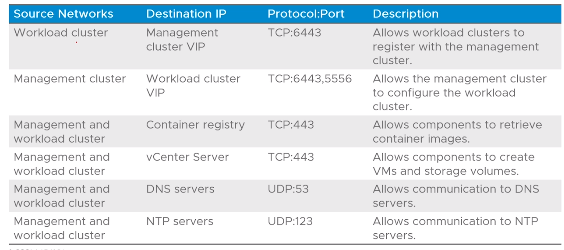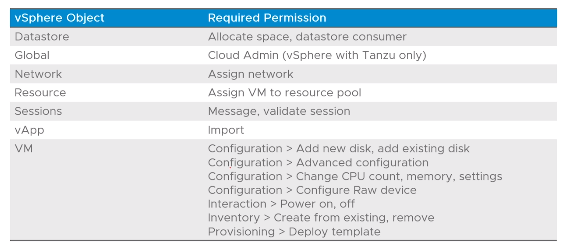2.1 - Overview of Management Clusters and Preparing the vSphere
Importance
Tanzu Kubernetes Grid management clusters offer Kubernetes lifecycle functionality of Tanzu Kubernetes Grid for the supported platforms e.g. vSphere and the workload clusters within.
vSphere Requirements
For vSphere deployment, Tanzu Kubernetes Grid requires:
vSphere 6.7 Update 3, vSphere 7, VMWare Cloud on AWS or Azure VMware Solution
A vSphere cluster with minimum 2 ESXi hosts and vSphere DRS enabled
A DHCP server to provide IP addresses to Tanzu Kubernetes grid management and workload clusters
Traffic to vCenter server allowed from the network on which the clusters run
A dedicated vCenter SSO account with permissions required for Tanzu Kubernetes Grid
Port Requirements
Dedicated vSphere SSO User
When deploying TKG using a dedicated vSphere SSO user, the TKG user should be assigned a role allowing access to the the following:
Datacenters or data center folders
Datastores or datastore folders
Hosts, clusters or resource pools
Networks to which the clusters are assigned
VM and template folders
SSH Key Pairs
An optional SSH public key is added to all VMs created by Tanzu Kubernetes Grid
The SSH key is used to remotely connect to a VM using SSH to troubleshoot/manage the VMs
If not provided, connecting to a control plane or worker node is not possible
OVA Templates
TKG provides base OS image templates in OVA format to import to vSphere:
Ubuntu v20.04 Kubernetes v1.xx.yy OVA (Default)
Photon v3 Kubernetes v1.xx.yy OVA
TKG creates the management cluster and TK cluster node VMs from these templates
After importing the OVA files, they must be converted to VM templates
The base OS image template includes the version of Kubernetes that TKG uses to create clusters
Deploying in Internet-Restricted Environments
Deploying in an Internet-Restricted environment is supported by loading all container images into a private Docker registry
Within firewall - install and configure a private Docker registry e.g. Harbor
Run docker pull to pull all the images required
Use docker tag and docker push to push them into the private registry
Set any required environment variables e.g. TKG_CUSTOM_IMAGE_REPOSITORY="registry URL"
Proceed with the normal installation steps

